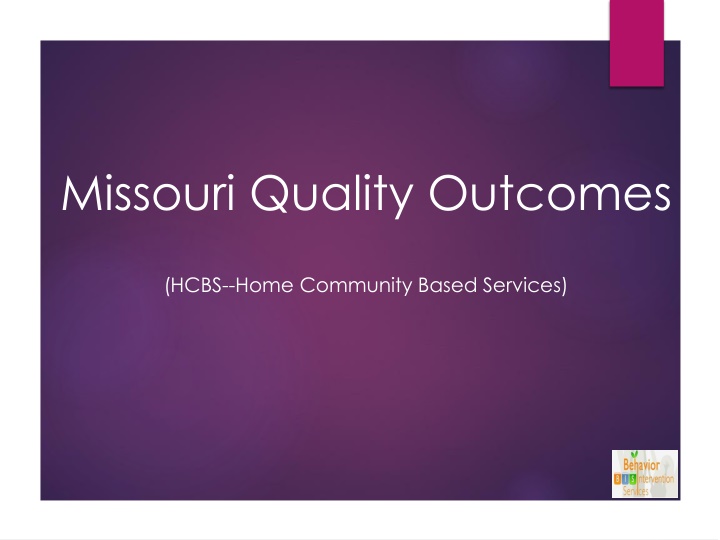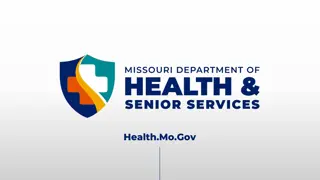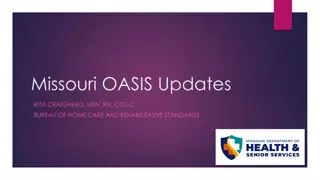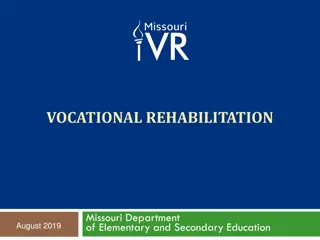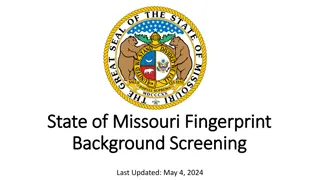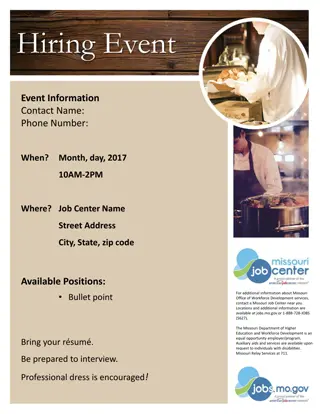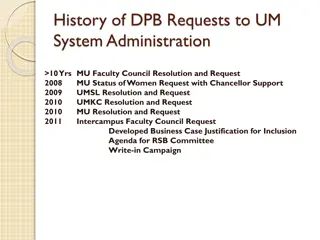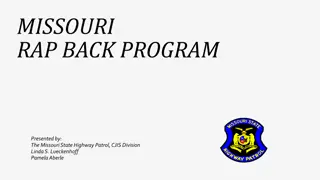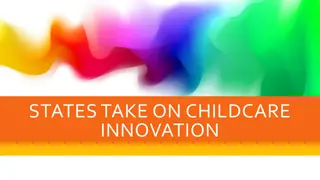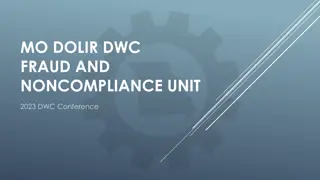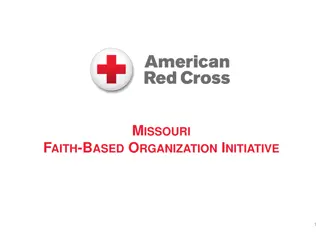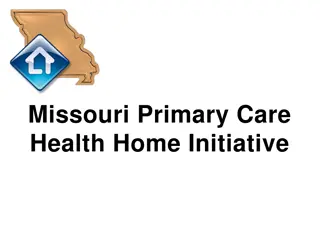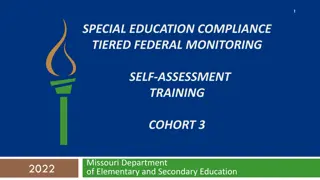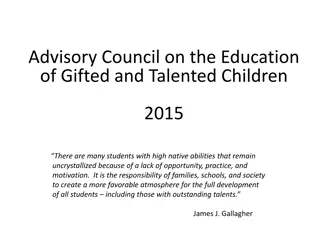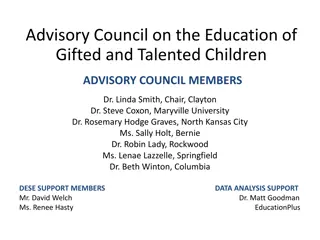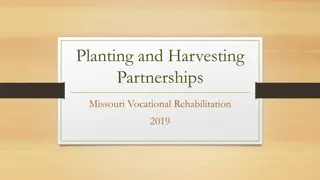Missouri Quality Outcomes
The Missouri Quality Outcomes focus on promoting personal quality of life outcomes for individuals with disabilities, emphasizing self-determination, personal values, choice, health, safety, inclusion, and self-advocacy. These outcomes guide discussions around key areas important to individual quality of life, supporting personal goals, dreams, and interests. Continuous efforts are needed to understand and assess individual quality of life within their support systems, leading to continuous improvement in services and supports for people with developmental disabilities.
Download Presentation

Please find below an Image/Link to download the presentation.
The content on the website is provided AS IS for your information and personal use only. It may not be sold, licensed, or shared on other websites without obtaining consent from the author.If you encounter any issues during the download, it is possible that the publisher has removed the file from their server.
You are allowed to download the files provided on this website for personal or commercial use, subject to the condition that they are used lawfully. All files are the property of their respective owners.
The content on the website is provided AS IS for your information and personal use only. It may not be sold, licensed, or shared on other websites without obtaining consent from the author.
E N D
Presentation Transcript
Missouri Quality Outcomes (HCBS--Home Community Based Services)
Purpose of Exercise Clients have the right to privacy Often, staff focus on taking care of the client instead of seeing them as people Our clients have the right to humane care and treatment and to be treated with dignity as a human being. 9CSR 45 3.030-1-A
People First Language This is essential Many refer to our clients by their disabilities which makes them objects and not people. Our clients will be free from the attitudes, beliefs and perceptions communicated by others which diminish their self-worth and standing in society. We will advocate for our clients so they are free from labels that separate, devalue or dehumanize them.
PURPOSE To introduce staff to the philosophy and practice of the Missouri Quality Outcomes To ensure continued efforts in supporting persons with disabilities to have improved quality of life. To utilize the Missouri Quality Outcomes in person centered planning to enhance the quality of life for person supported.
The Missouri Quality Outcomes were developed as a result of listening to people with disabilities, their families, and advocates. The outcomes were designed to encourage personal quality of life outcomes with individual focus on leading a self- determined life; including personal values, choice, health, safety, inclusion and self-advocacy.
The Missouri Quality Outcomes are intended to be a guide to assist the user with facilitating discussion around key areas of importance to the individual and supporting their personal goals, dreams and other areas of interest to the individual that defines quality of life. Improving quality requires continuous efforts on getting to know the person in the settings and situation where they are supported, as well as, consistent interaction and involvement with the individual and their support systems for on-going assessment of their quality of life.
The Missouri Quality Outcomes will be measured through annual data collected by the Division of Developmental Disabilities. Based on the data, the Division of Developmental Disabilities will address areas of enhancements to services and supports through policies and practices, with the goal of provided continuous improvement for people with developmental disabilities.
Assumptions People with disabilities are the customers Quality improvement is based on getting to know the person in the environments and situations where they are supported Quality improvement efforts are based on the Division s Quality Outcomes Quality improvement is the responsibility of everyone.
Information obtained through quality improvement efforts needs to be shared and used to produce needed change Providers and DMRDD are business partners Typical life in the community is the benchmark for quality of life Improving quality is dependent upon regular interaction with and involvement of people with disabilities throughout the process
Outcome 1 People belong to their community.
Level of Participation Passive Participation spectator Minimal Participation customer Full Participation contributor, organization/committee member, decision making, knowing people involved Right to Refuse
Question How are you involved in your community compared to your clients? What is your level of participation compared to your clients? Is going to a nursey to look at the plants because the person you support likes flowers a meaningful outing?
Outcome 2 People have a variety of personal relationships
Missouri Proclamation (freedom to live a meaningful life*) People exercise the right to choose their relationships: the people with who they spend their time, share personal details or are intimate. People are inspired by other s high expectations for them, helping them strive to become all they can be. Limited, or no expectations, restricts people s growth, advances stereotypes, and leads to labeled incompetence and poverty, instead of self-determined lives.
Outcome 3 People have valued roles in their family and in their community
Positive RolesValued VS. Negative Roles Not Valued
Supporting Positive Roles This requires careful planning to enhance the person s skills so that he/she can learn the role and eventually meet the expectations of the role with or without support.
How do we accomplish this with the people we serve?
Outcome 4 People s communication is understood and receives a response
Do people only communicate using words? Who determines how someone communicates? Do we have the right to change how someone communicates?
Communication Staff uses the person s language or understand their means of communication The person has an effective means of communication The person has an effective means of indicating choice Communication charts (personal dictionaries) that include what staff should do in response to the person s communication Others translate respectfully, when needed
Communicate for themselves Communicates freely with others Encouraged to communicate Continuous opportunities to communicate Environment promotes communication Feel listened to Communication is respected Communication is reciprocal, ongoing and interactive Verbal and non-verbal communication is responded to
Intent of communication is understood Communication needs addressed with a sense of urgency Adaptive equipment is with the person at all times Person and staff know how to use the equipment Repair/replacement of adaptive equipment occurs quickly respecting the person s sense of urgency Functional alternatives used consistently when primary means are not available
Do You Really Listen? Five ways to be a better listener Stop talking Avoid distractions Concentrated on what the other person is saying Look for a REAL meaning Provide feedback to the sender
Outcome 5 People are provided behavioral supports in positive ways
Behavior is a form of communication A person s plan (individualized centered plan/ISP) will address how to support the person with behavioral challenges in positive ways.
What should we be careful of when addressing behavioral challenges?
Outcome 6 People are provided support in a manner that creates a positive image
Positive Image Portrayed in the best light to others in the community Avoiding stereotypical dress, hairstyle, places and activities Positive personal appearance Project a positive impression Image of personal worth and competence
Positive Image Pride in accomplishments Core belief that the person is valued and capable Engaged in valued, positive activities Being alone or in small groups when in the community Spends the majority of time in integrated settings
Outcome 7 People express their own personal identity
What is your personal identity? Activity: List 3 things that identify your personal style. Those things that make you different from others, i.e. way you dress, how you decorate your home, music you listen to, etc. Now list 3 things that identify one of your client s personal style.
Outcome 8 People have control of their daily lives
Who has control in your life? Activity: What are three rules in your home? Who determined these rules? What happens if someone breaks the rules? 1) 2) 3) Who makes the rules in the homes of the clients we serve? Who shouldn t make the rules?
Informed Choice Our goal should be providing informed choice. We should provide our clients with the information they need in order to make an informed decision. Our clients have the right to fail. Risk is acceptable, even when it results in a person not being successful. The outcomes of their choices should not affect their value as human beings. Our clients have the right to learn and grow. Everyone on the planning team needs to understand our clients are the primary drivers of their own life choices and decisions, and their right to make decisions for themselves, with or without assistance, is respected, encouraged, and supported.
Outcome 9 People have the opportunity to advocate for themselves, for others and for causes they believe in
Advocate What does it mean to advocate or be a self- advocate? According to People First of Missouri: Learn how to speak up for ourselves. Making our own decisions about what we want to do with our lives. How do we assist our clients in doing this
How do we advocate? Learning how to get all the information that is needed to understand a topic Assisting our clients in finding out what and who will support them in meeting their goals Knowing/teaching rights and responsibilities to our clients Feeling good about learning from their mistakes Problem solving when things go wrong
How do we advocate? Listening to and helping each other Reaching out to people who are not members Learning about self-determination
Outcome 10 People s plans reflect how they want to live their lives, the supports they want, and how they want them provided
Person Centered Plan (PCP) Everyone has a PCP Our clients have the right to direct their own person- centered planning process and to choose others to be included or excluded from the process. You are a part of the person s planning team The PCP contains information about needed supports i.e. health, behavioral, supervision, safety, etc. They have the right to decline supports and services
Outcome 11 People live and die with dignity
Living with Dignity Behavior Intervention Services is determined to support our clients throughout their entire life. Our clients shouldn t be isolated from the people in their community. Our clients should understand their right to privacy. Our clients should always be treated with dignity and respect. Examples of what not to do.
Dying with Dignity Our clients have the right to make end of life decisions and advance directives. They shouldn t be made without their consent. They shouldn t fear that the circumstance of their existence is deemed to costly or too difficult.
Outcome 12 People feel safe and experience emotional well being
Activity What are some things that make you feel safe? What are some things that make you feel unsafe? How do we control our fears so we don t project them onto our clients/
Outcome 13 People are supported to attain physical wellness
What are some things that make you feel healthy? What are some things that make you feel unhealthy? How do we motivate our clients to become healthier without the use of restrictions?
Outcome 14 People are actively supported throughout the process of making major life style changes
